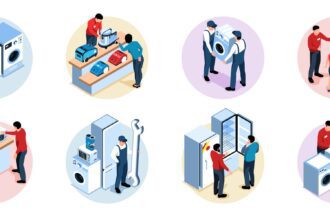When it comes to appliance repair, understanding your home’s appliances is crucial. Knowing how they work and what can go wrong helps you identify problems early on, saving you time and money in the long run.
Chapter 1: Kitchen Appliances
The kitchen is where most of your daily meals are prepared, making it a hub of activity. Understanding your kitchen appliances ensures that meal prep goes smoothly.
Refrigerator Repair
Your refrigerator keeps your food fresh by maintaining a cool temperature. A faulty thermostat or compressor can cause temperature fluctuations, leading to spoiled food. Regular cleaning and maintenance can prevent these issues.
Signs You Need Refrigerator Repair
- Unusual noises or vibrations
- Temperature fluctuations
- Water leaks or ice buildup
Oven Repair
Your oven is responsible for cooking your meals to perfection. A faulty heating element or thermostat can lead to undercooked or burnt food. Regular cleaning and maintenance can prevent these issues.
Signs You Need Oven Repair
- Inconsistent cooking results
- Unusual odors or smoke
- Faulty display or temperature settings
Dishwasher Repair
Your dishwasher makes cleaning up after meals a breeze. A faulty pump or detergent dispenser can lead to poor washing performance. Regular cleaning and maintenance can prevent these issues.
Signs You Need Dishwasher Repair
- Poor washing performance
- Unusual noises or leaks
- Faulty display or cycle settings
Chapter 2: Laundry Appliances
Your laundry room is where you clean your clothes, making it an essential part of your daily routine. Understanding your laundry appliances ensures that your clothes come out clean and fresh.
Washing Machine Repair
Your washing machine cleans your clothes by agitating and rinsing them. A faulty motor or gearbox can lead to poor washing performance. Regular cleaning and maintenance can prevent these issues.
Signs You Need Washing Machine Repair
- Poor washing performance
- Unusual noises or vibrations
- Leaks or water damage
Dryer Repair
Your dryer dries your clothes by circulating hot air. A faulty heating element or thermostat can lead to poor drying performance. Regular cleaning and maintenance can prevent these issues.
Signs You Need Dryer Repair
- Poor drying performance
- Unusual noises or vibrations
- Faulty display or temperature settings
Chapter 3: HVAC Appliances
Your HVAC system keeps your home comfortable by regulating the temperature. Understanding your HVAC appliances ensures that you stay cool in the summer and warm in the winter.
Air Conditioning Repair
Your air conditioner cools your home by circulating cold air. A faulty compressor or condenser coil can lead to poor cooling performance. Regular cleaning and maintenance can prevent these issues.
Signs You Need Air Conditioning Repair
- Poor cooling performance
- Unusual noises or vibrations
- Leaks or water damage
Heating Repair
Your heater warms your home by circulating hot air. A faulty heating element or thermostat can lead to poor heating performance. Regular cleaning and maintenance can prevent these issues.
Signs You Need Heating Repair
- Poor heating performance
- Unusual noises or vibrations
- Faulty display or temperature settings
Understanding your home’s appliances is crucial for identifying problems early on, saving you time and money in the long run. By recognizing the signs of appliance repair needs, you can take proactive steps to prevent issues from arising.
Additional Tips
- Regularly clean and maintain your appliances
- Check for recalls or manufacturer updates
- Consider hiring a professional for complex repairs
By following these tips and understanding your home’s appliances, you’ll be well on your way to ensuring that your appliances run smoothly and efficiently.
